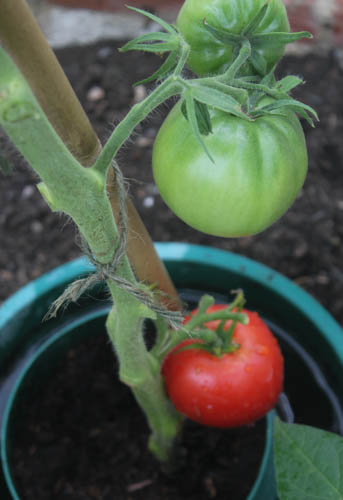
Early in the month, especially if it is warm and sunny, sow trays, pots or old growing bags with ‘cut and come again crops’ to harvest through autumn and into winter, think land cress, oriental salads, like pak choi, mizuna and mibuna greens plus lettuce, lamb’s lettuce, chicory and radish. You can also use what’s left from earlier brassica sowings and you can also harvest them earlier as microgreens.
Reduce watering and damping down as temperatures drop and during cloudy periods.
Take semi ripe cuttings from tender plants like pelargoniums and salvias for overwintering.
Towards the end of the month, start lifting and potting up tender plants for overwintering in a frost-free glasshouse along with divisions of chives, lemon balm, mint and French tarragon, to extend the cropping season into autumn.
Clean the outside of the greenhouse on a warm autumn day using environmentally friendly detergents, then rinse with clean water. A broom is useful for scrubbing if you can’t reach by hand and a pressure washer, if you have one, will help, too. Use an old kitchen knife or plant label to scrape moss growing between overlapping panes. Leave the interior until you have cleared away the tomatoes and other tender crops then take the opportunity to tidy, clean and disinfect the inside glasshouse, while you can move plants outside and the weather is still warm.
Composting Aubergines that have finished cropping, creates more space in the greenhouse border and between pots on the bench, capturing more sunlight and improving air circulation around the plants that remain. Early in the month, remove the leaves around aubergines, tomatoes, peppers and cucumbers and continue feeding with high potash fertiliser to encourage ripening.
Later in the month, trusses of unripe tomatoes can be removed from the plant and ripened under cloches, greenhouse benches or a warm sunny windowsill and winter crops planted in their place (see above). It’s been a rotten summer weather wise, here and in the south east and much wetter and duller than normal (not so in Scotland and Northern Ireland, where sunshine has increased the mean average temperature by one degree). Low light and cold weather, including unseasonal northerly winds have made conditions less than ideal for tender crops, confirmed by the fact that my best performing tomatoes have been a heritage variety ‘Nepal’ from the Sikkim Himalayas. This variety also keeps well. Perfect fruits can be picked when green, stored, wrapped in tissue just as you would apples, then ripened in warmer conditions for home-grown tomatoes to Christmas and beyond. My mother used to do this with a range of varieties which she picked then stored in the cool spare bedroom in a chest of draws, leaving 10cm between each fruit. She checked them regularly, removing any showin signs of deterioration.
September is the ideal month for treating vine weevil with biological control. You should also eradicate pests and diseases from tender plants before bringing them into the greenhouse (or house) over winter. Happy gardening, Matt.










